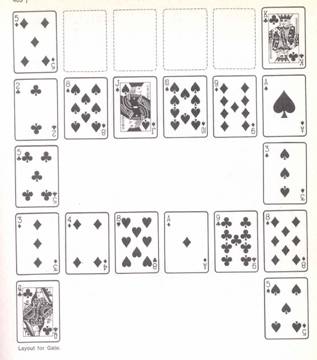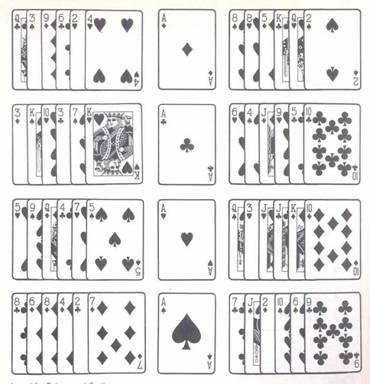Beleaguered Castle
Foundations. The four aces, as they become available, are moved to a row above the gate and built up in suit to kings.
Layout. Deal the rest of the pack into two wings of a tableau, one on each side of the foundations. Each wing is made up of four rows of six cards each, the cards in each row overlapping. The customary method is to deal by columns. First deal a column just to the right of the aces to start the right wing. continue dealing to the wings alternate, a column at a time, each column overlapping the previous column at the left.

Layout for Gate.
Play. only one card at a time at the open end of each row is available. The open end is that having the uncovered card. Available cards may be played on foundations or may be built on each other, downward, without regard to suit. A Space made by removal of an entire row may be filled by any available card.
Citadel
This is a variation of Beleaguered Castle which may seem easier to some players. Follow all rules for Beleaguered Castle, except: Do not place the aces at the outset, but deal them to the center column in the course of laying out the tableau. Any deuce turned up in dealing may be built on its ace already in the center; and so on. A card turned from the pack in dealing may be played to the center if the foundation is ready for it; but a card once laid on the tableau may not be touched again until the deal is complete. When a card is so played to the center, do not replace it by the tableau where it would have gone. The completed tableau rows will thus not be of uniform length.

Layout for Beleaguered Castle.
Streets and Alleys
This is Beleaguered Castle made more difficult, but it is unlikely that you will find the parent game too easy. Follow all rules for Beleaguered Castle except: Do not place the aces at the outset; Move them into position as they become available. Deal an extra column of card loo to the left wing of the tableau, making four rows of seven.
Fortress
This game is perhaps the most popular poker game of those in which the whole pack is laid out.
Layout. Deal the entire pack in two wings of a tableau, each wing consisting of five rows with the cards of each row overlapping. The top two rows are six cards, the other, five. The customary method of dealing is by columns. After completing five columns in each wing, place the last two cards on the ends of the two top rows.
Foundations. The four aces, as they become available, are foundations that are moved to a column between the wings, to be built up in suit to kings.
Play. Only one card at a time may be moved from the open ends of the rows. End cards are available for play on foundation, or to be built on each other in suit, either up or down.
Chessboard
The layout for Fortress too frequently shows no possible move. Such an impasse can usually be circumvented in Chessboard. Follow rules for fortress except: after dealing the layout, choose any available card (it may be one made available by building) for the first foundation. The three other cards of the same rank are moved to the center, as they become available. Build each foundation up in suit until the suit is complete.
La Belle Lucie
Layout. Deal the entire pack into 17 fans of three card loo each with one card left over. The simplest method of dealing is to count off three cards at a time from the top of the pack and turn them face up, overlapped.
Foundations. The four aces, as they become available, are placed in a row and built up in suit to kings.
Play. Only one card at a time may be moved from the top of a fan. Top cards are available for building on foundations, or building on each other, down, in suit. A space formed by removal of an entire fan is never filled.
Redeal. Two redeals are permitted. To redeal, pick up all the cards exclusive of piles (foundations ) and shuffle cards them thoroughly. Then deal again in fans of three, with any one or two odd cards at the end in a separate pile.
Draw. After the last redeal, any one card below the top of a fan may be drawn out and used on foundations or fan builds
